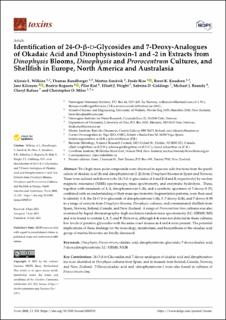Identification of 24-O-β-d-Glycosides and 7-Deoxy-Analogues of Okadaic Acid and Dinophysistoxin-1 and -2 in Extracts from Dinophysis Blooms, Dinophysis and Prorocentrum Cultures, and Shellfish in Europe, North America and Australasia
Wilkins, Alistair L.; Rundberget, Thomas; Sandvik, Morten; Rise, Frode; Knudsen, Brent K.; Kilcoyne, Jane; Reguera, Beatriz; Rial, Pilar; Wright, Elliot J.; Giddings, Sabrina D.; Boundy, Michael J.; Rafuse, Cheryl; Miles, Christopher O.
Peer reviewed, Journal article
Published version
Permanent lenke
https://hdl.handle.net/11250/2772481Utgivelsesdato
2021Metadata
Vis full innførselSamlinger
- Publikasjoner fra Cristin - NIVA [2160]
- Scientific publications [1172]
Sammendrag
Two high-mass polar compounds were observed in aqueous side-fractions from the purification of okadaic acid (1) and dinophysistoxin-2 (2) from Dinophysis blooms in Spain and Norway. These were isolated and shown to be 24-O-β-d-glucosides of 1 and 2 (4 and 5, respectively) by nuclear magnetic resonance (NMR) spectroscopy, mass spectrometry, and enzymatic hydrolysis. These, together with standards of 1, 2, dinophysistoxin-1 (3), and a synthetic specimen of 7-deoxy-1 (7), combined with an understanding of their mass spectrometric fragmentation patterns, were then used to identify 1–5, the 24-O-β-d-glucoside of dinophysistoxin-1 (6), 7, 7-deoxy-2 (8), and 7-deoxy-3 (9) in a range of extracts from Dinophysis blooms, Dinophysis cultures, and contaminated shellfish from Spain, Norway, Ireland, Canada, and New Zealand. A range of Prorocentrum lima cultures was also examined by liquid chromatography–high resolution tandem mass spectrometry (LC–HRMS/MS) and was found to contain 1, 3, 7, and 9. However, although 4–6 were not detected in these cultures, low levels of putative glycosides with the same exact masses as 4 and 6 were present. The potential implications of these findings for the toxicology, metabolism, and biosynthesis of the okadaic acid group of marine biotoxins are briefly discussed.

